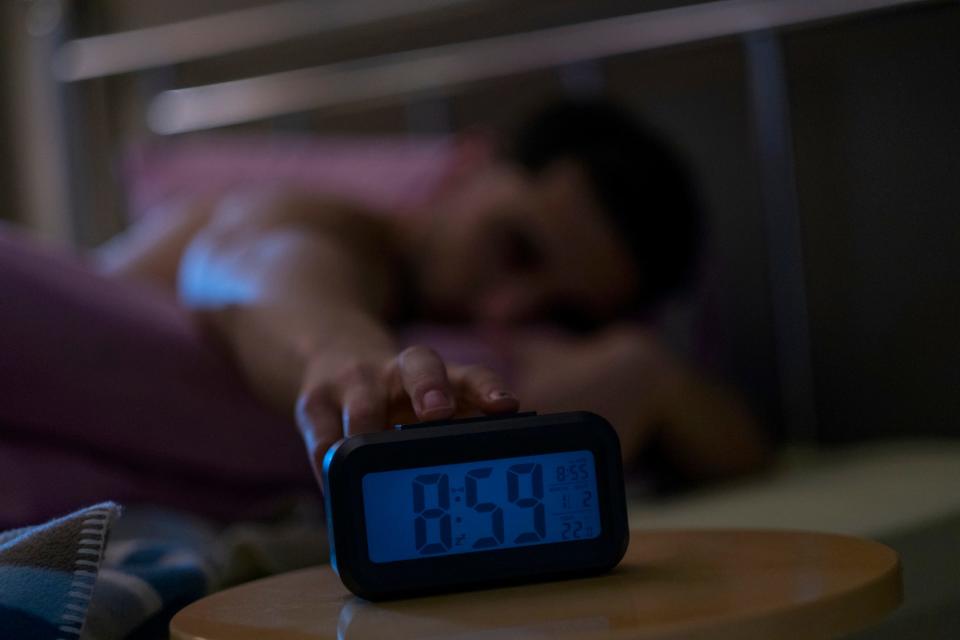Don’t get too comfortable with standard time because in a few weeks you’ll be changing your clocks once again.
Daylight saving time will kick off next month, requiring Americans to dreadfully lose an hour of sleep as time shifts ahead by one hour.
On the bright side, the time change will delay the moment day becomes night for those hoping to walk their dogs outside before it gets dark.
Twice-annual time changes have been practiced since daylight saving time’s adoption in 1918. Yet many Americans have expressed frustration with the constant time shifts with the exception of the two states that don’t participate in the human-invented phenomenon.
Advertisement
Advertisement
Here’s what to know about the state of daylight saving time, including the efforts to make it year-round or remove it altogether.

Man turns off alarm clock in bed
When does daylight saving time start?
Daylight saving time is set to begin on Sunday, March 9.
What is daylight saving time?
Daylight saving time is the time between March and November when most Americans adjust their clocks ahead by one hour.
We lose an hour in March (as opposed to gaining an hour in the fall) to make for more daylight in the summer evenings. In the Northern Hemisphere, the vernal, or spring equinox, is on March 20, marking the start of the spring season.
What’s the truth? Sign up for USA TODAY’s Checking the Facts newsletter for all the answers.
Why do we have daylight saving time?
Most people have heard the myth that daylight saving time came about to give farmers an extra hour of sunlight in the evening.
Advertisement
Advertisement
But in reality, farmers led the opposition to daylight saving time in 1919, a year after it was implemented in the U.S. as a wartime measure.
“The sun, not the clock, dictated farmers’ schedules, so daylight saving was very disruptive,” according to History.com. “Farmers had to wait an extra hour for dew to evaporate to harvest hay, hired hands worked less since they still left at the same time for dinner and cows weren’t ready to be milked an hour earlier to meet shipping schedules.”
Nationwide daylight saving time was repealed in 1919, though states and cities still had the option to enact it for themselves, leading to a patchwork of time zones across the country until the Uniform Time Act passed in 1966.
Has Trump passed legislation on daylight saving time?
Trump has yet to pass any executive orders to permanently end daylight saving time.
When did federal time changes start?
The Standard Time Act of 1918 was the first law to implement standard and daylight saving times at the federal level.
Advertisement
Advertisement
More in World
“Federal oversight of time zones began in 1918 with the enactment of the Standard Time Act, which vested the Interstate Commerce Commission with the responsibility for establishing boundaries between the standard time zones in the U.S.,” according to The U.S. Department of Transportation. “This responsibility was transferred from the Interstate Commerce Commission to DOT when Congress created DOT in 1966.”
Who is in charge of daylight saving time?
The DOT oversees the observance of daylight saving time, as well as U.S. time zones, according to transportation.gov. The DOT cited energy reduction and reduced crime are reasons for having both standard and daylight saving time.
Which states don’t observe daylight saving time?
Hawaii and most of Arizona do not observe daylight saving time. Because of its desert climate, Arizona doesn’t follow daylight saving time (with the exception of the Navajo Nation). After most of the U.S. adopted the Uniform Time Act, the state figured that there wasn’t a good reason to adjust clocks to make sunset occur an hour later during the hottest months of the year.
Contributing: Alexis Simmerman, Jana Hayes, The Oklahoman, Emily DeLetter, Jennifer Sangalang, USA TODAY Network.
This article originally appeared on USA TODAY: Daylight saving time 2025: Here’s when you will lose an hour of sleep
EMEA Tribune is not involved in this news article, it is taken from our partners and or from the News Agencies. Copyright and Credit go to the News Agencies, email news@emeatribune.com Follow our WhatsApp verified Channel




